Business Strategy Report: Sustainable Practices at NatWest Bank
VerifiedAdded on 2020/04/21
|21
|4023
|30
Report
AI Summary
This report analyzes the sustainable strategy of NatWest Bank, a major UK retail and commercial bank. It begins with a problem statement addressing online banking failures and their impact on reputation and stakeholder relations. The report then delves into a PESTEL analysis, examining political (Brexit), economic, social, technological, environmental, and legal factors influencing the bank. Competitive dynamics are explored using Porter's Five Forces, assessing buyer and supplier power, competitive rivalry, and the threat of substitution and new entrants. Critical success factors, including strategic planning, sponsorships, and collaborations, are also identified. Task 2 focuses on the bank's position statement, strategy diamond, sustainability arena, vehicle (Ansoff Matrix), differentiation (Bowman's Strategy Clock), staging, and economic logic. Finally, it evaluates measures for sustainable strategy implementation, providing a comprehensive overview of NatWest's strategic approach.
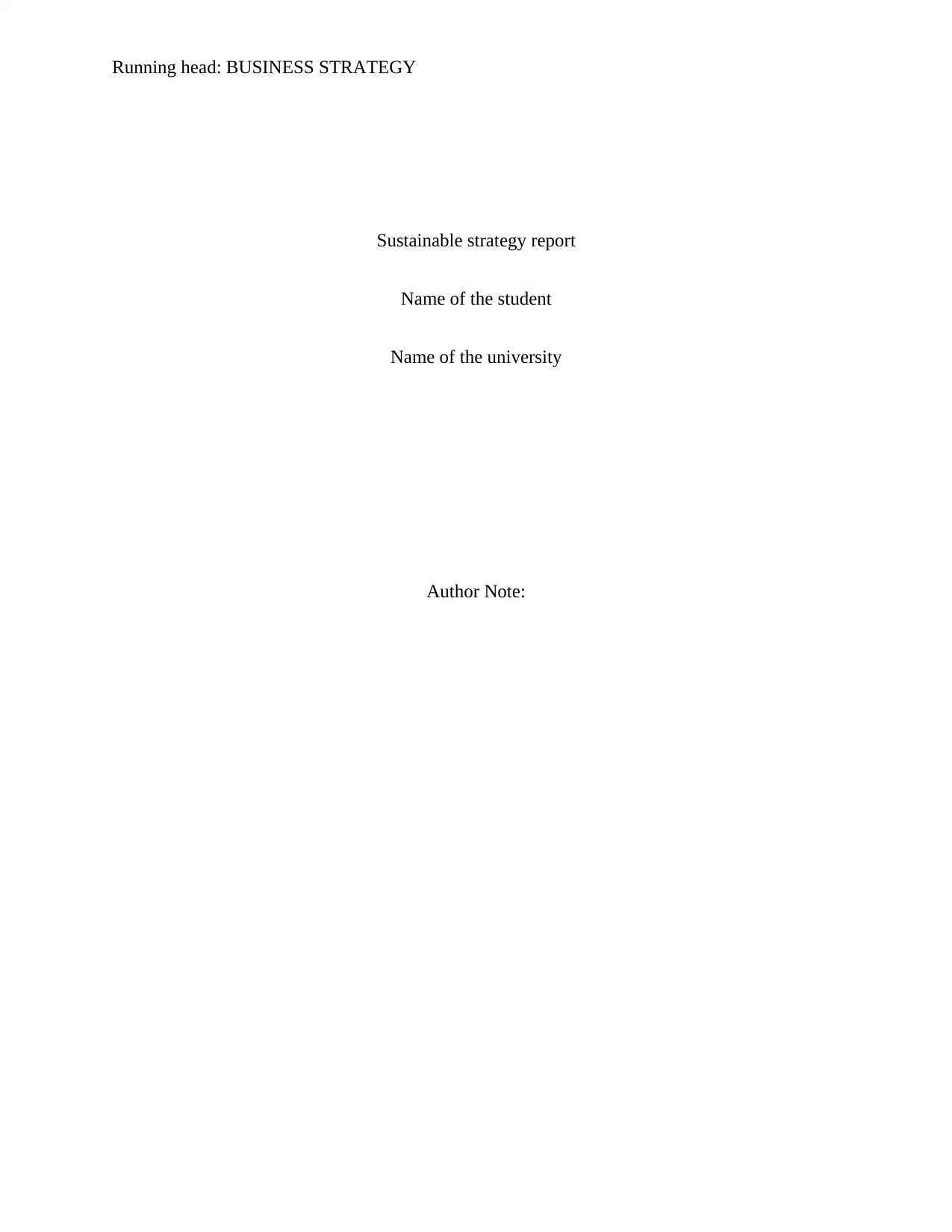
Running head: BUSINESS STRATEGY
Sustainable strategy report
Name of the student
Name of the university
Author Note:
Sustainable strategy report
Name of the student
Name of the university
Author Note:
Paraphrase This Document
Need a fresh take? Get an instant paraphrase of this document with our AI Paraphraser
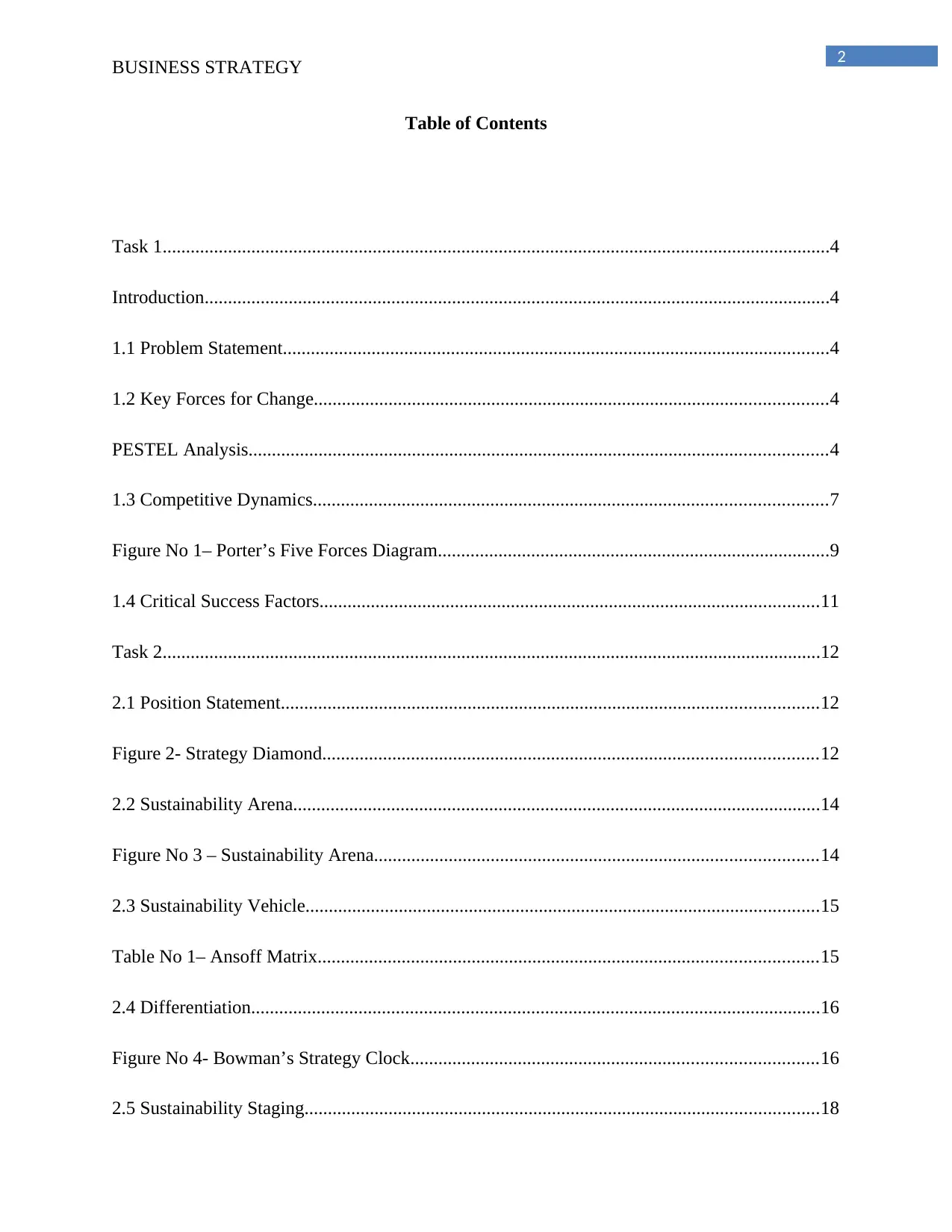
2
BUSINESS STRATEGY
Table of Contents
Task 1...............................................................................................................................................4
Introduction......................................................................................................................................4
1.1 Problem Statement.....................................................................................................................4
1.2 Key Forces for Change..............................................................................................................4
PESTEL Analysis............................................................................................................................4
1.3 Competitive Dynamics..............................................................................................................7
Figure No 1– Porter’s Five Forces Diagram....................................................................................9
1.4 Critical Success Factors...........................................................................................................11
Task 2.............................................................................................................................................12
2.1 Position Statement...................................................................................................................12
Figure 2- Strategy Diamond..........................................................................................................12
2.2 Sustainability Arena.................................................................................................................14
Figure No 3 – Sustainability Arena...............................................................................................14
2.3 Sustainability Vehicle..............................................................................................................15
Table No 1– Ansoff Matrix...........................................................................................................15
2.4 Differentiation..........................................................................................................................16
Figure No 4- Bowman’s Strategy Clock.......................................................................................16
2.5 Sustainability Staging..............................................................................................................18
BUSINESS STRATEGY
Table of Contents
Task 1...............................................................................................................................................4
Introduction......................................................................................................................................4
1.1 Problem Statement.....................................................................................................................4
1.2 Key Forces for Change..............................................................................................................4
PESTEL Analysis............................................................................................................................4
1.3 Competitive Dynamics..............................................................................................................7
Figure No 1– Porter’s Five Forces Diagram....................................................................................9
1.4 Critical Success Factors...........................................................................................................11
Task 2.............................................................................................................................................12
2.1 Position Statement...................................................................................................................12
Figure 2- Strategy Diamond..........................................................................................................12
2.2 Sustainability Arena.................................................................................................................14
Figure No 3 – Sustainability Arena...............................................................................................14
2.3 Sustainability Vehicle..............................................................................................................15
Table No 1– Ansoff Matrix...........................................................................................................15
2.4 Differentiation..........................................................................................................................16
Figure No 4- Bowman’s Strategy Clock.......................................................................................16
2.5 Sustainability Staging..............................................................................................................18
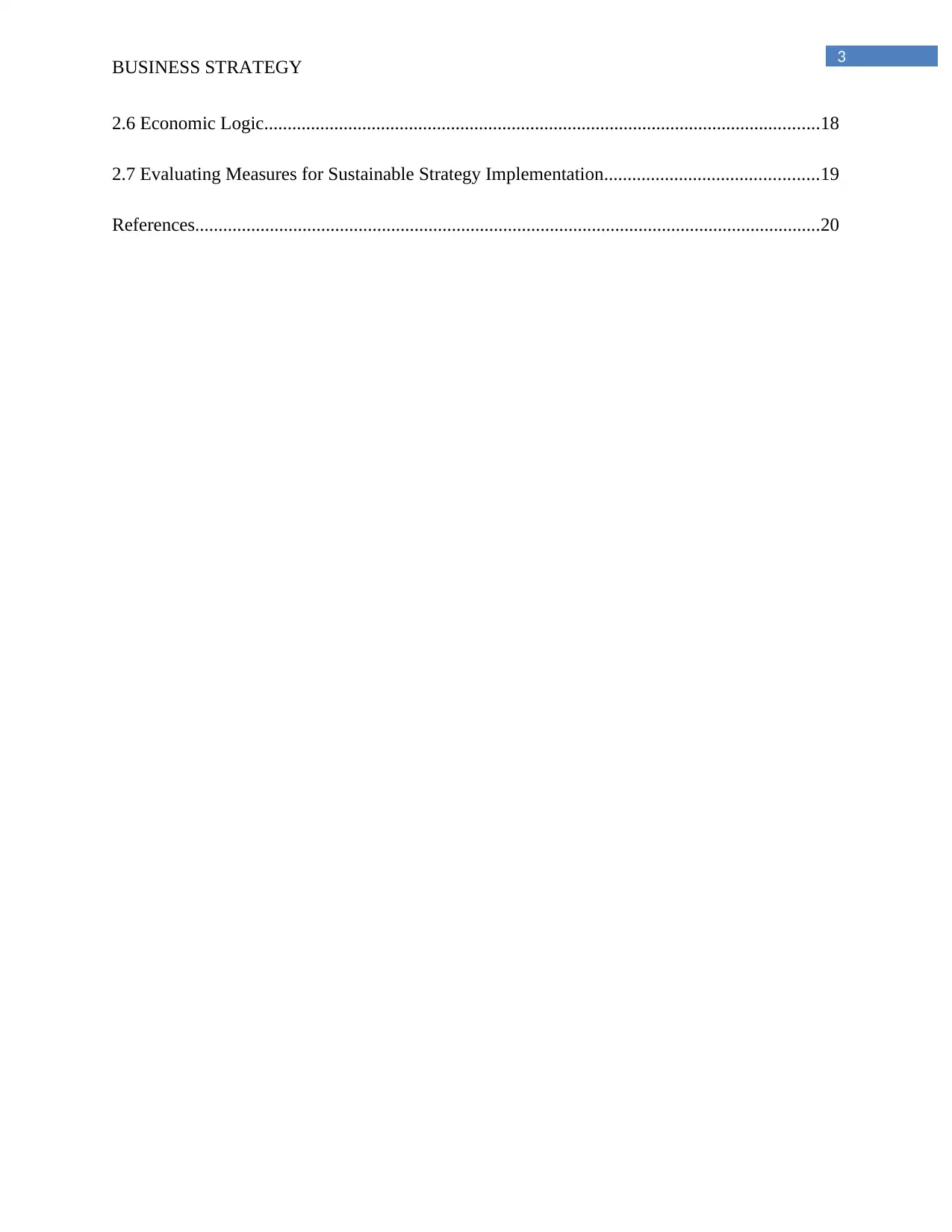
3
BUSINESS STRATEGY
2.6 Economic Logic.......................................................................................................................18
2.7 Evaluating Measures for Sustainable Strategy Implementation..............................................19
References......................................................................................................................................20
BUSINESS STRATEGY
2.6 Economic Logic.......................................................................................................................18
2.7 Evaluating Measures for Sustainable Strategy Implementation..............................................19
References......................................................................................................................................20
⊘ This is a preview!⊘
Do you want full access?
Subscribe today to unlock all pages.

Trusted by 1+ million students worldwide
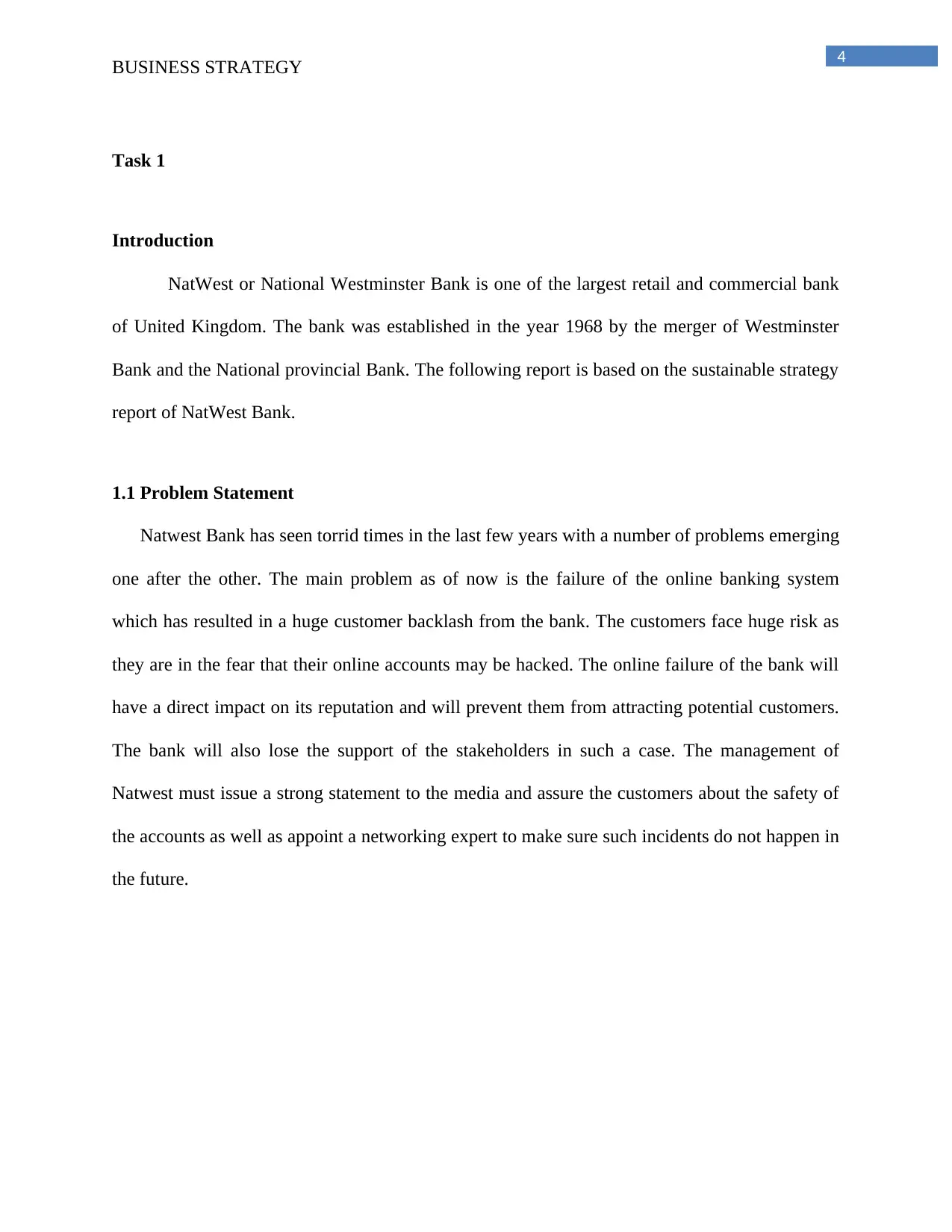
4
BUSINESS STRATEGY
Task 1
Introduction
NatWest or National Westminster Bank is one of the largest retail and commercial bank
of United Kingdom. The bank was established in the year 1968 by the merger of Westminster
Bank and the National provincial Bank. The following report is based on the sustainable strategy
report of NatWest Bank.
1.1 Problem Statement
Natwest Bank has seen torrid times in the last few years with a number of problems emerging
one after the other. The main problem as of now is the failure of the online banking system
which has resulted in a huge customer backlash from the bank. The customers face huge risk as
they are in the fear that their online accounts may be hacked. The online failure of the bank will
have a direct impact on its reputation and will prevent them from attracting potential customers.
The bank will also lose the support of the stakeholders in such a case. The management of
Natwest must issue a strong statement to the media and assure the customers about the safety of
the accounts as well as appoint a networking expert to make sure such incidents do not happen in
the future.
BUSINESS STRATEGY
Task 1
Introduction
NatWest or National Westminster Bank is one of the largest retail and commercial bank
of United Kingdom. The bank was established in the year 1968 by the merger of Westminster
Bank and the National provincial Bank. The following report is based on the sustainable strategy
report of NatWest Bank.
1.1 Problem Statement
Natwest Bank has seen torrid times in the last few years with a number of problems emerging
one after the other. The main problem as of now is the failure of the online banking system
which has resulted in a huge customer backlash from the bank. The customers face huge risk as
they are in the fear that their online accounts may be hacked. The online failure of the bank will
have a direct impact on its reputation and will prevent them from attracting potential customers.
The bank will also lose the support of the stakeholders in such a case. The management of
Natwest must issue a strong statement to the media and assure the customers about the safety of
the accounts as well as appoint a networking expert to make sure such incidents do not happen in
the future.
Paraphrase This Document
Need a fresh take? Get an instant paraphrase of this document with our AI Paraphraser
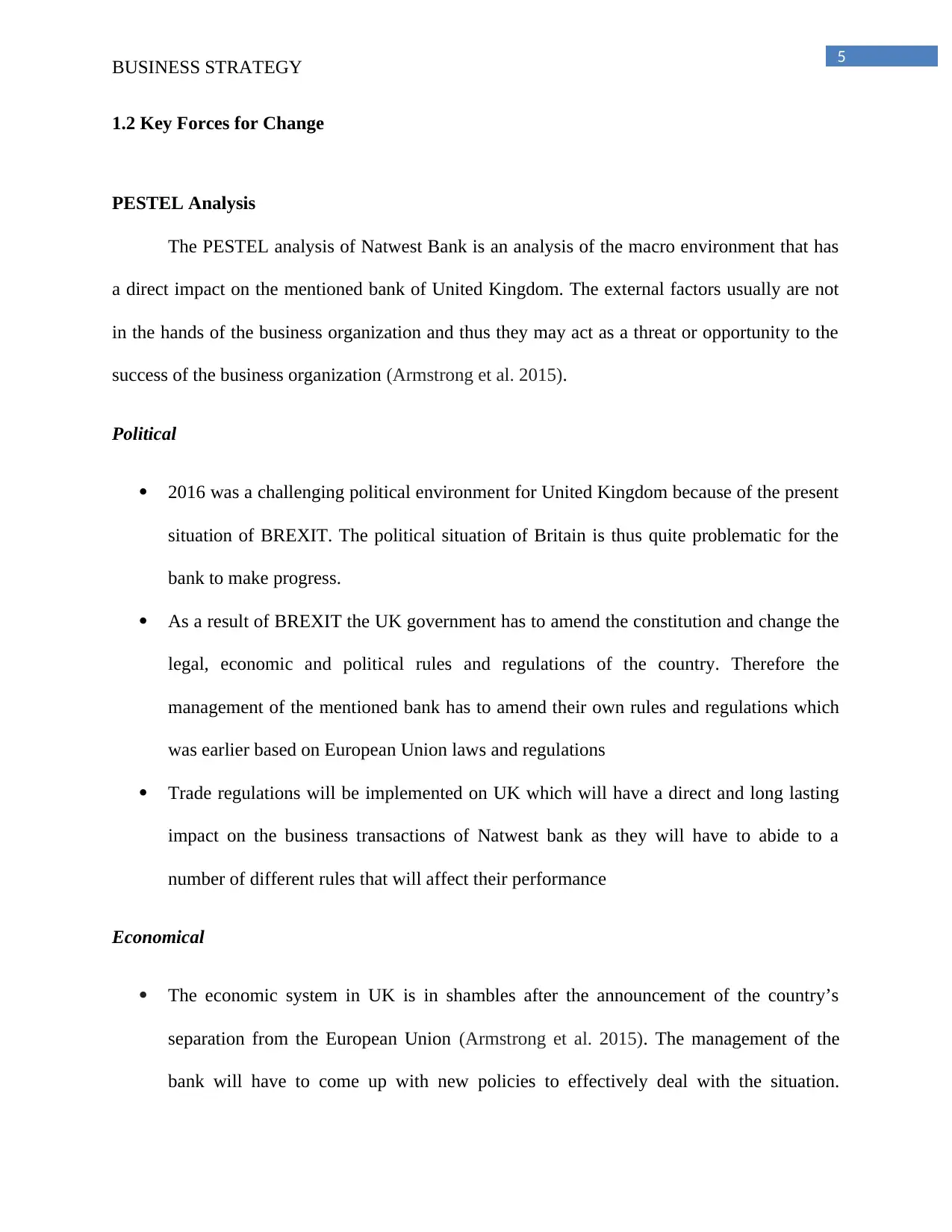
5
BUSINESS STRATEGY
1.2 Key Forces for Change
PESTEL Analysis
The PESTEL analysis of Natwest Bank is an analysis of the macro environment that has
a direct impact on the mentioned bank of United Kingdom. The external factors usually are not
in the hands of the business organization and thus they may act as a threat or opportunity to the
success of the business organization (Armstrong et al. 2015).
Political
2016 was a challenging political environment for United Kingdom because of the present
situation of BREXIT. The political situation of Britain is thus quite problematic for the
bank to make progress.
As a result of BREXIT the UK government has to amend the constitution and change the
legal, economic and political rules and regulations of the country. Therefore the
management of the mentioned bank has to amend their own rules and regulations which
was earlier based on European Union laws and regulations
Trade regulations will be implemented on UK which will have a direct and long lasting
impact on the business transactions of Natwest bank as they will have to abide to a
number of different rules that will affect their performance
Economical
The economic system in UK is in shambles after the announcement of the country’s
separation from the European Union (Armstrong et al. 2015). The management of the
bank will have to come up with new policies to effectively deal with the situation.
BUSINESS STRATEGY
1.2 Key Forces for Change
PESTEL Analysis
The PESTEL analysis of Natwest Bank is an analysis of the macro environment that has
a direct impact on the mentioned bank of United Kingdom. The external factors usually are not
in the hands of the business organization and thus they may act as a threat or opportunity to the
success of the business organization (Armstrong et al. 2015).
Political
2016 was a challenging political environment for United Kingdom because of the present
situation of BREXIT. The political situation of Britain is thus quite problematic for the
bank to make progress.
As a result of BREXIT the UK government has to amend the constitution and change the
legal, economic and political rules and regulations of the country. Therefore the
management of the mentioned bank has to amend their own rules and regulations which
was earlier based on European Union laws and regulations
Trade regulations will be implemented on UK which will have a direct and long lasting
impact on the business transactions of Natwest bank as they will have to abide to a
number of different rules that will affect their performance
Economical
The economic system in UK is in shambles after the announcement of the country’s
separation from the European Union (Armstrong et al. 2015). The management of the
bank will have to come up with new policies to effectively deal with the situation.
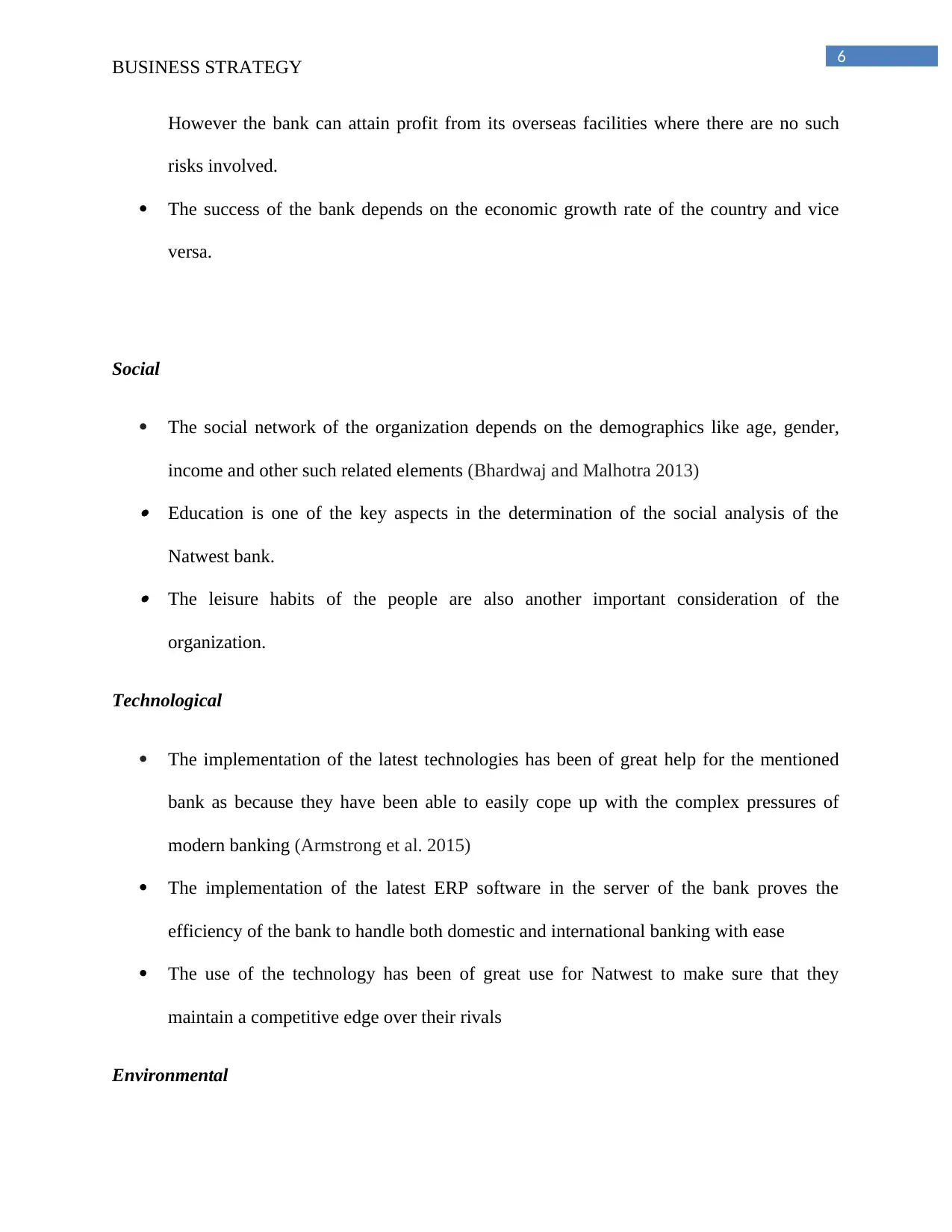
6
BUSINESS STRATEGY
However the bank can attain profit from its overseas facilities where there are no such
risks involved.
The success of the bank depends on the economic growth rate of the country and vice
versa.
Social
The social network of the organization depends on the demographics like age, gender,
income and other such related elements (Bhardwaj and Malhotra 2013) Education is one of the key aspects in the determination of the social analysis of the
Natwest bank. The leisure habits of the people are also another important consideration of the
organization.
Technological
The implementation of the latest technologies has been of great help for the mentioned
bank as because they have been able to easily cope up with the complex pressures of
modern banking (Armstrong et al. 2015)
The implementation of the latest ERP software in the server of the bank proves the
efficiency of the bank to handle both domestic and international banking with ease
The use of the technology has been of great use for Natwest to make sure that they
maintain a competitive edge over their rivals
Environmental
BUSINESS STRATEGY
However the bank can attain profit from its overseas facilities where there are no such
risks involved.
The success of the bank depends on the economic growth rate of the country and vice
versa.
Social
The social network of the organization depends on the demographics like age, gender,
income and other such related elements (Bhardwaj and Malhotra 2013) Education is one of the key aspects in the determination of the social analysis of the
Natwest bank. The leisure habits of the people are also another important consideration of the
organization.
Technological
The implementation of the latest technologies has been of great help for the mentioned
bank as because they have been able to easily cope up with the complex pressures of
modern banking (Armstrong et al. 2015)
The implementation of the latest ERP software in the server of the bank proves the
efficiency of the bank to handle both domestic and international banking with ease
The use of the technology has been of great use for Natwest to make sure that they
maintain a competitive edge over their rivals
Environmental
⊘ This is a preview!⊘
Do you want full access?
Subscribe today to unlock all pages.

Trusted by 1+ million students worldwide
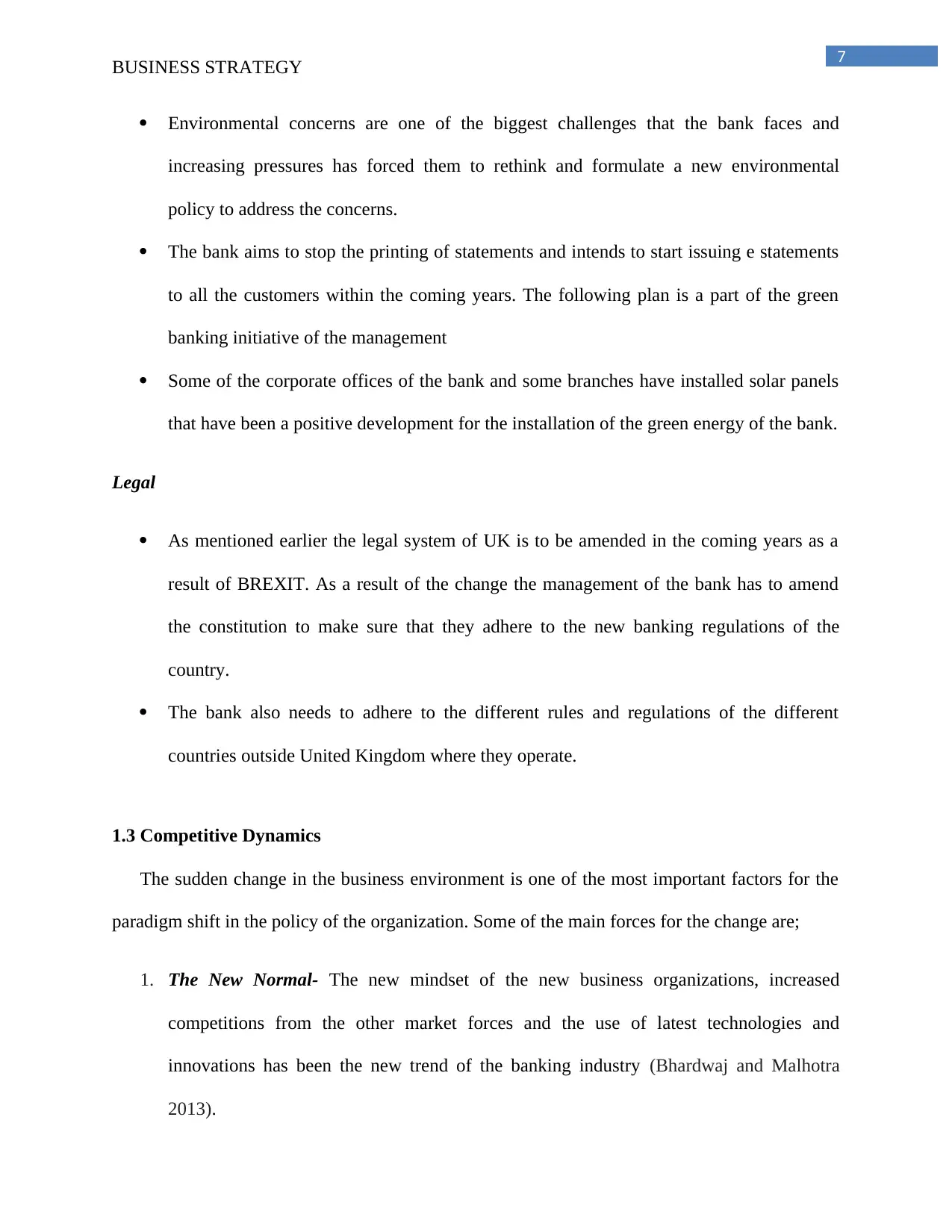
7
BUSINESS STRATEGY
Environmental concerns are one of the biggest challenges that the bank faces and
increasing pressures has forced them to rethink and formulate a new environmental
policy to address the concerns.
The bank aims to stop the printing of statements and intends to start issuing e statements
to all the customers within the coming years. The following plan is a part of the green
banking initiative of the management
Some of the corporate offices of the bank and some branches have installed solar panels
that have been a positive development for the installation of the green energy of the bank.
Legal
As mentioned earlier the legal system of UK is to be amended in the coming years as a
result of BREXIT. As a result of the change the management of the bank has to amend
the constitution to make sure that they adhere to the new banking regulations of the
country.
The bank also needs to adhere to the different rules and regulations of the different
countries outside United Kingdom where they operate.
1.3 Competitive Dynamics
The sudden change in the business environment is one of the most important factors for the
paradigm shift in the policy of the organization. Some of the main forces for the change are;
1. The New Normal- The new mindset of the new business organizations, increased
competitions from the other market forces and the use of latest technologies and
innovations has been the new trend of the banking industry (Bhardwaj and Malhotra
2013).
BUSINESS STRATEGY
Environmental concerns are one of the biggest challenges that the bank faces and
increasing pressures has forced them to rethink and formulate a new environmental
policy to address the concerns.
The bank aims to stop the printing of statements and intends to start issuing e statements
to all the customers within the coming years. The following plan is a part of the green
banking initiative of the management
Some of the corporate offices of the bank and some branches have installed solar panels
that have been a positive development for the installation of the green energy of the bank.
Legal
As mentioned earlier the legal system of UK is to be amended in the coming years as a
result of BREXIT. As a result of the change the management of the bank has to amend
the constitution to make sure that they adhere to the new banking regulations of the
country.
The bank also needs to adhere to the different rules and regulations of the different
countries outside United Kingdom where they operate.
1.3 Competitive Dynamics
The sudden change in the business environment is one of the most important factors for the
paradigm shift in the policy of the organization. Some of the main forces for the change are;
1. The New Normal- The new mindset of the new business organizations, increased
competitions from the other market forces and the use of latest technologies and
innovations has been the new trend of the banking industry (Bhardwaj and Malhotra
2013).
Paraphrase This Document
Need a fresh take? Get an instant paraphrase of this document with our AI Paraphraser
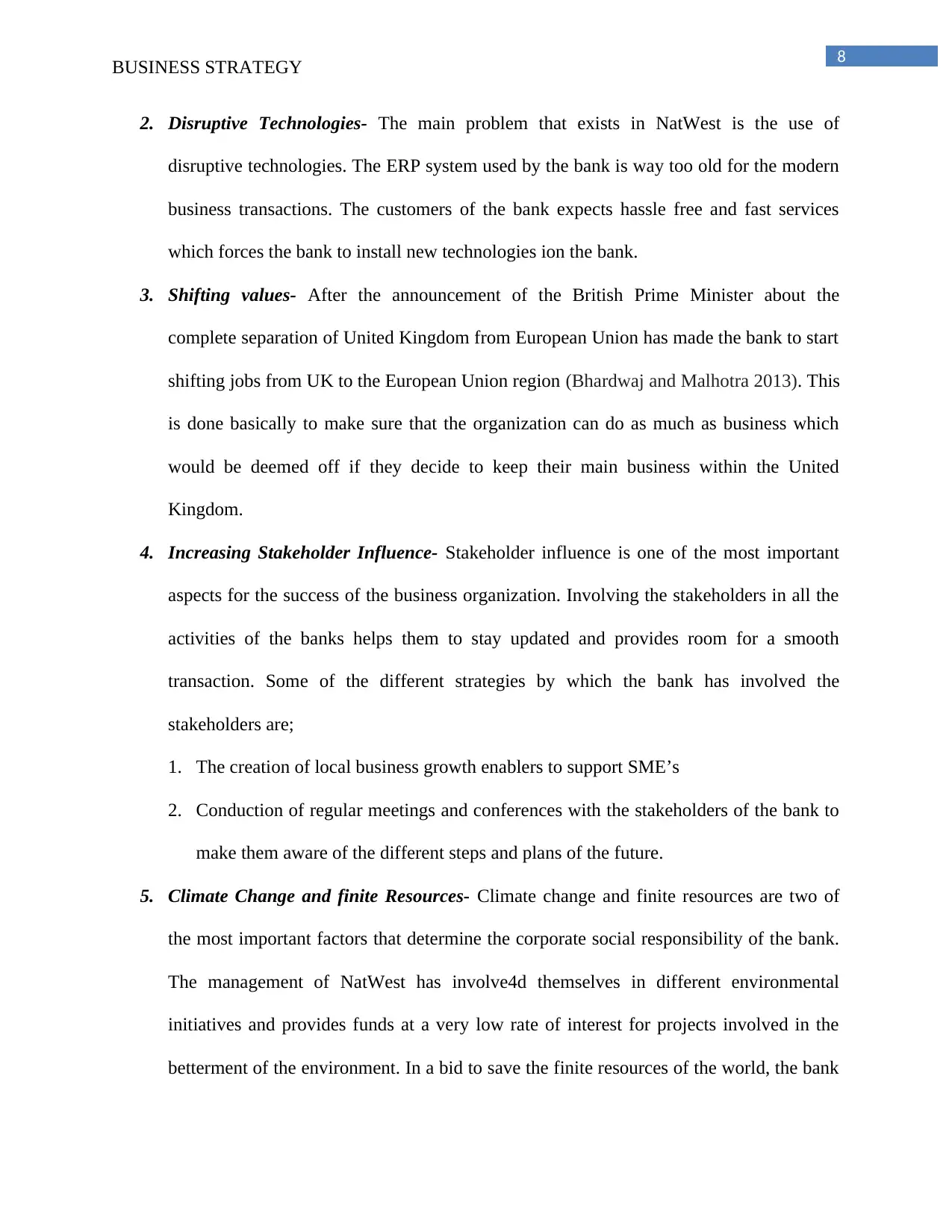
8
BUSINESS STRATEGY
2. Disruptive Technologies- The main problem that exists in NatWest is the use of
disruptive technologies. The ERP system used by the bank is way too old for the modern
business transactions. The customers of the bank expects hassle free and fast services
which forces the bank to install new technologies ion the bank.
3. Shifting values- After the announcement of the British Prime Minister about the
complete separation of United Kingdom from European Union has made the bank to start
shifting jobs from UK to the European Union region (Bhardwaj and Malhotra 2013). This
is done basically to make sure that the organization can do as much as business which
would be deemed off if they decide to keep their main business within the United
Kingdom.
4. Increasing Stakeholder Influence- Stakeholder influence is one of the most important
aspects for the success of the business organization. Involving the stakeholders in all the
activities of the banks helps them to stay updated and provides room for a smooth
transaction. Some of the different strategies by which the bank has involved the
stakeholders are;
1. The creation of local business growth enablers to support SME’s
2. Conduction of regular meetings and conferences with the stakeholders of the bank to
make them aware of the different steps and plans of the future.
5. Climate Change and finite Resources- Climate change and finite resources are two of
the most important factors that determine the corporate social responsibility of the bank.
The management of NatWest has involve4d themselves in different environmental
initiatives and provides funds at a very low rate of interest for projects involved in the
betterment of the environment. In a bid to save the finite resources of the world, the bank
BUSINESS STRATEGY
2. Disruptive Technologies- The main problem that exists in NatWest is the use of
disruptive technologies. The ERP system used by the bank is way too old for the modern
business transactions. The customers of the bank expects hassle free and fast services
which forces the bank to install new technologies ion the bank.
3. Shifting values- After the announcement of the British Prime Minister about the
complete separation of United Kingdom from European Union has made the bank to start
shifting jobs from UK to the European Union region (Bhardwaj and Malhotra 2013). This
is done basically to make sure that the organization can do as much as business which
would be deemed off if they decide to keep their main business within the United
Kingdom.
4. Increasing Stakeholder Influence- Stakeholder influence is one of the most important
aspects for the success of the business organization. Involving the stakeholders in all the
activities of the banks helps them to stay updated and provides room for a smooth
transaction. Some of the different strategies by which the bank has involved the
stakeholders are;
1. The creation of local business growth enablers to support SME’s
2. Conduction of regular meetings and conferences with the stakeholders of the bank to
make them aware of the different steps and plans of the future.
5. Climate Change and finite Resources- Climate change and finite resources are two of
the most important factors that determine the corporate social responsibility of the bank.
The management of NatWest has involve4d themselves in different environmental
initiatives and provides funds at a very low rate of interest for projects involved in the
betterment of the environment. In a bid to save the finite resources of the world, the bank
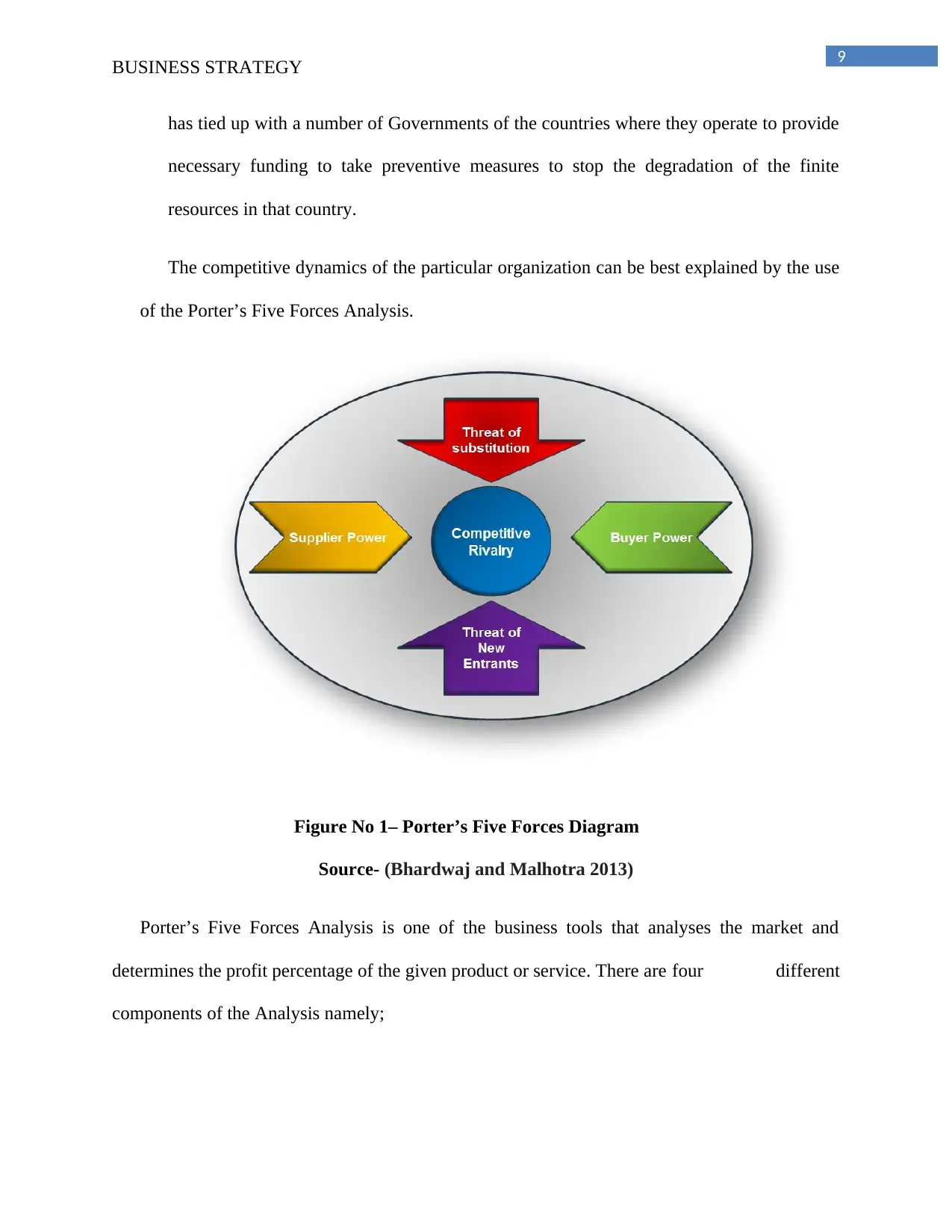
9
BUSINESS STRATEGY
has tied up with a number of Governments of the countries where they operate to provide
necessary funding to take preventive measures to stop the degradation of the finite
resources in that country.
The competitive dynamics of the particular organization can be best explained by the use
of the Porter’s Five Forces Analysis.
Figure No 1– Porter’s Five Forces Diagram
Source- (Bhardwaj and Malhotra 2013)
Porter’s Five Forces Analysis is one of the business tools that analyses the market and
determines the profit percentage of the given product or service. There are four different
components of the Analysis namely;
BUSINESS STRATEGY
has tied up with a number of Governments of the countries where they operate to provide
necessary funding to take preventive measures to stop the degradation of the finite
resources in that country.
The competitive dynamics of the particular organization can be best explained by the use
of the Porter’s Five Forces Analysis.
Figure No 1– Porter’s Five Forces Diagram
Source- (Bhardwaj and Malhotra 2013)
Porter’s Five Forces Analysis is one of the business tools that analyses the market and
determines the profit percentage of the given product or service. There are four different
components of the Analysis namely;
⊘ This is a preview!⊘
Do you want full access?
Subscribe today to unlock all pages.

Trusted by 1+ million students worldwide
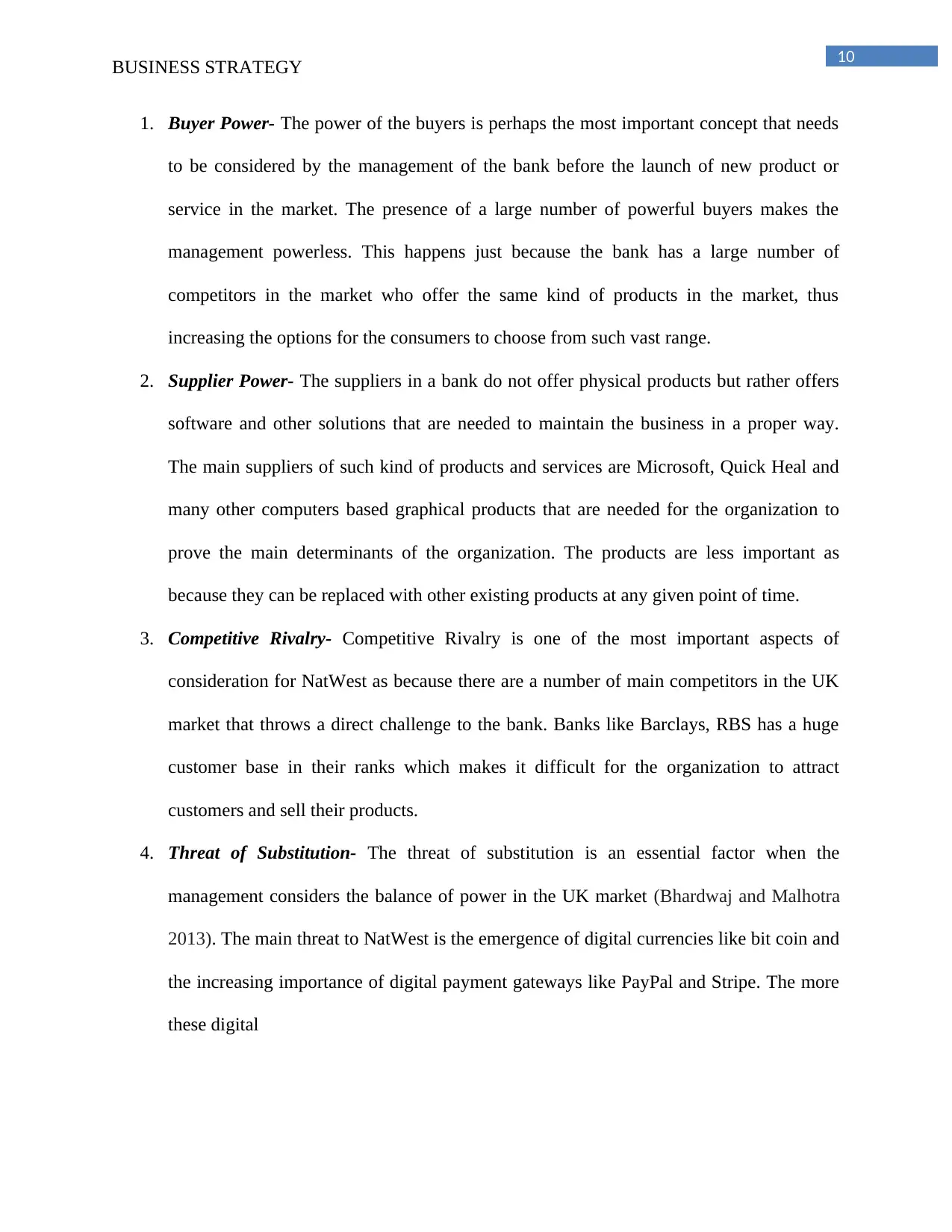
10
BUSINESS STRATEGY
1. Buyer Power- The power of the buyers is perhaps the most important concept that needs
to be considered by the management of the bank before the launch of new product or
service in the market. The presence of a large number of powerful buyers makes the
management powerless. This happens just because the bank has a large number of
competitors in the market who offer the same kind of products in the market, thus
increasing the options for the consumers to choose from such vast range.
2. Supplier Power- The suppliers in a bank do not offer physical products but rather offers
software and other solutions that are needed to maintain the business in a proper way.
The main suppliers of such kind of products and services are Microsoft, Quick Heal and
many other computers based graphical products that are needed for the organization to
prove the main determinants of the organization. The products are less important as
because they can be replaced with other existing products at any given point of time.
3. Competitive Rivalry- Competitive Rivalry is one of the most important aspects of
consideration for NatWest as because there are a number of main competitors in the UK
market that throws a direct challenge to the bank. Banks like Barclays, RBS has a huge
customer base in their ranks which makes it difficult for the organization to attract
customers and sell their products.
4. Threat of Substitution- The threat of substitution is an essential factor when the
management considers the balance of power in the UK market (Bhardwaj and Malhotra
2013). The main threat to NatWest is the emergence of digital currencies like bit coin and
the increasing importance of digital payment gateways like PayPal and Stripe. The more
these digital
BUSINESS STRATEGY
1. Buyer Power- The power of the buyers is perhaps the most important concept that needs
to be considered by the management of the bank before the launch of new product or
service in the market. The presence of a large number of powerful buyers makes the
management powerless. This happens just because the bank has a large number of
competitors in the market who offer the same kind of products in the market, thus
increasing the options for the consumers to choose from such vast range.
2. Supplier Power- The suppliers in a bank do not offer physical products but rather offers
software and other solutions that are needed to maintain the business in a proper way.
The main suppliers of such kind of products and services are Microsoft, Quick Heal and
many other computers based graphical products that are needed for the organization to
prove the main determinants of the organization. The products are less important as
because they can be replaced with other existing products at any given point of time.
3. Competitive Rivalry- Competitive Rivalry is one of the most important aspects of
consideration for NatWest as because there are a number of main competitors in the UK
market that throws a direct challenge to the bank. Banks like Barclays, RBS has a huge
customer base in their ranks which makes it difficult for the organization to attract
customers and sell their products.
4. Threat of Substitution- The threat of substitution is an essential factor when the
management considers the balance of power in the UK market (Bhardwaj and Malhotra
2013). The main threat to NatWest is the emergence of digital currencies like bit coin and
the increasing importance of digital payment gateways like PayPal and Stripe. The more
these digital
Paraphrase This Document
Need a fresh take? Get an instant paraphrase of this document with our AI Paraphraser
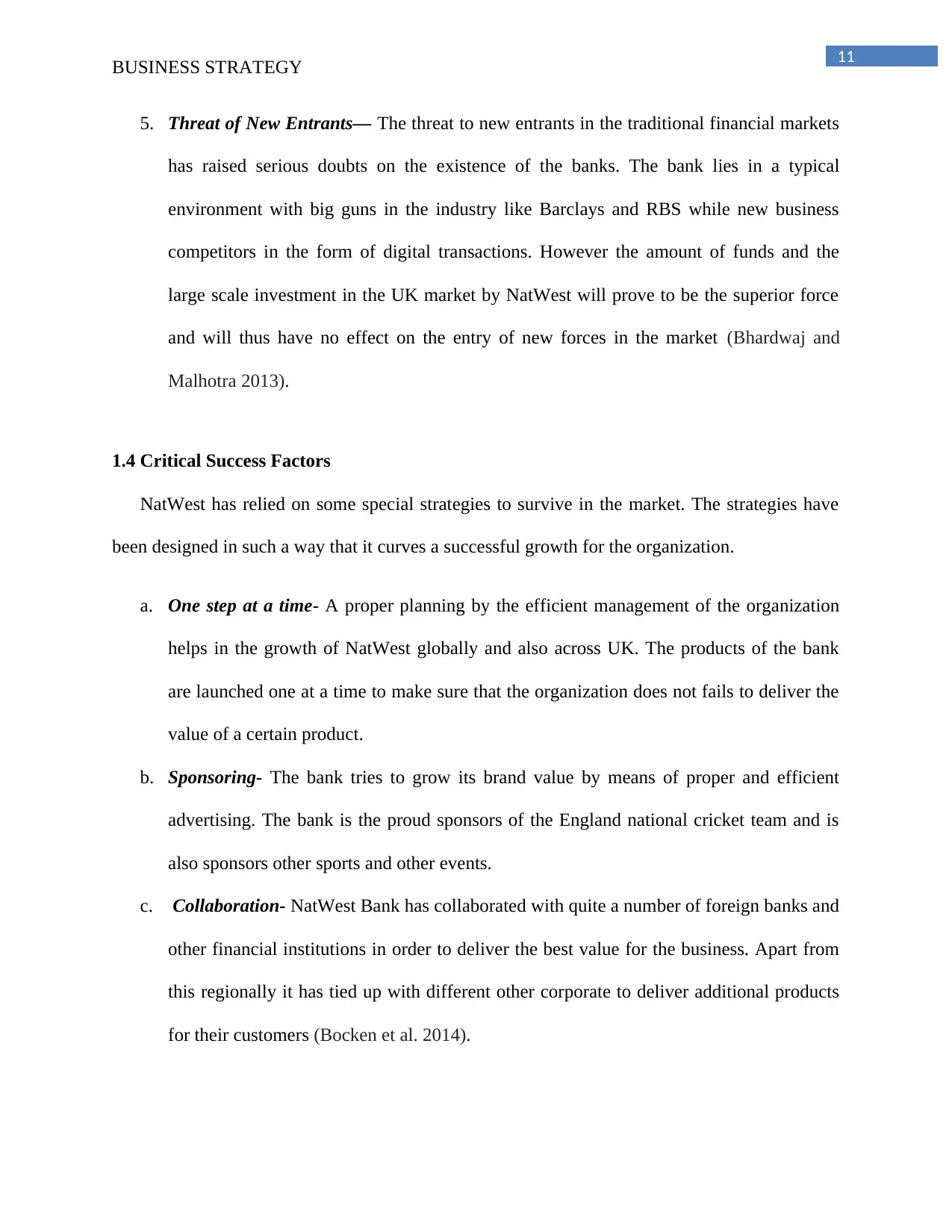
11
BUSINESS STRATEGY
5. Threat of New Entrants— The threat to new entrants in the traditional financial markets
has raised serious doubts on the existence of the banks. The bank lies in a typical
environment with big guns in the industry like Barclays and RBS while new business
competitors in the form of digital transactions. However the amount of funds and the
large scale investment in the UK market by NatWest will prove to be the superior force
and will thus have no effect on the entry of new forces in the market (Bhardwaj and
Malhotra 2013).
1.4 Critical Success Factors
NatWest has relied on some special strategies to survive in the market. The strategies have
been designed in such a way that it curves a successful growth for the organization.
a. One step at a time- A proper planning by the efficient management of the organization
helps in the growth of NatWest globally and also across UK. The products of the bank
are launched one at a time to make sure that the organization does not fails to deliver the
value of a certain product.
b. Sponsoring- The bank tries to grow its brand value by means of proper and efficient
advertising. The bank is the proud sponsors of the England national cricket team and is
also sponsors other sports and other events.
c. Collaboration- NatWest Bank has collaborated with quite a number of foreign banks and
other financial institutions in order to deliver the best value for the business. Apart from
this regionally it has tied up with different other corporate to deliver additional products
for their customers (Bocken et al. 2014).
BUSINESS STRATEGY
5. Threat of New Entrants— The threat to new entrants in the traditional financial markets
has raised serious doubts on the existence of the banks. The bank lies in a typical
environment with big guns in the industry like Barclays and RBS while new business
competitors in the form of digital transactions. However the amount of funds and the
large scale investment in the UK market by NatWest will prove to be the superior force
and will thus have no effect on the entry of new forces in the market (Bhardwaj and
Malhotra 2013).
1.4 Critical Success Factors
NatWest has relied on some special strategies to survive in the market. The strategies have
been designed in such a way that it curves a successful growth for the organization.
a. One step at a time- A proper planning by the efficient management of the organization
helps in the growth of NatWest globally and also across UK. The products of the bank
are launched one at a time to make sure that the organization does not fails to deliver the
value of a certain product.
b. Sponsoring- The bank tries to grow its brand value by means of proper and efficient
advertising. The bank is the proud sponsors of the England national cricket team and is
also sponsors other sports and other events.
c. Collaboration- NatWest Bank has collaborated with quite a number of foreign banks and
other financial institutions in order to deliver the best value for the business. Apart from
this regionally it has tied up with different other corporate to deliver additional products
for their customers (Bocken et al. 2014).
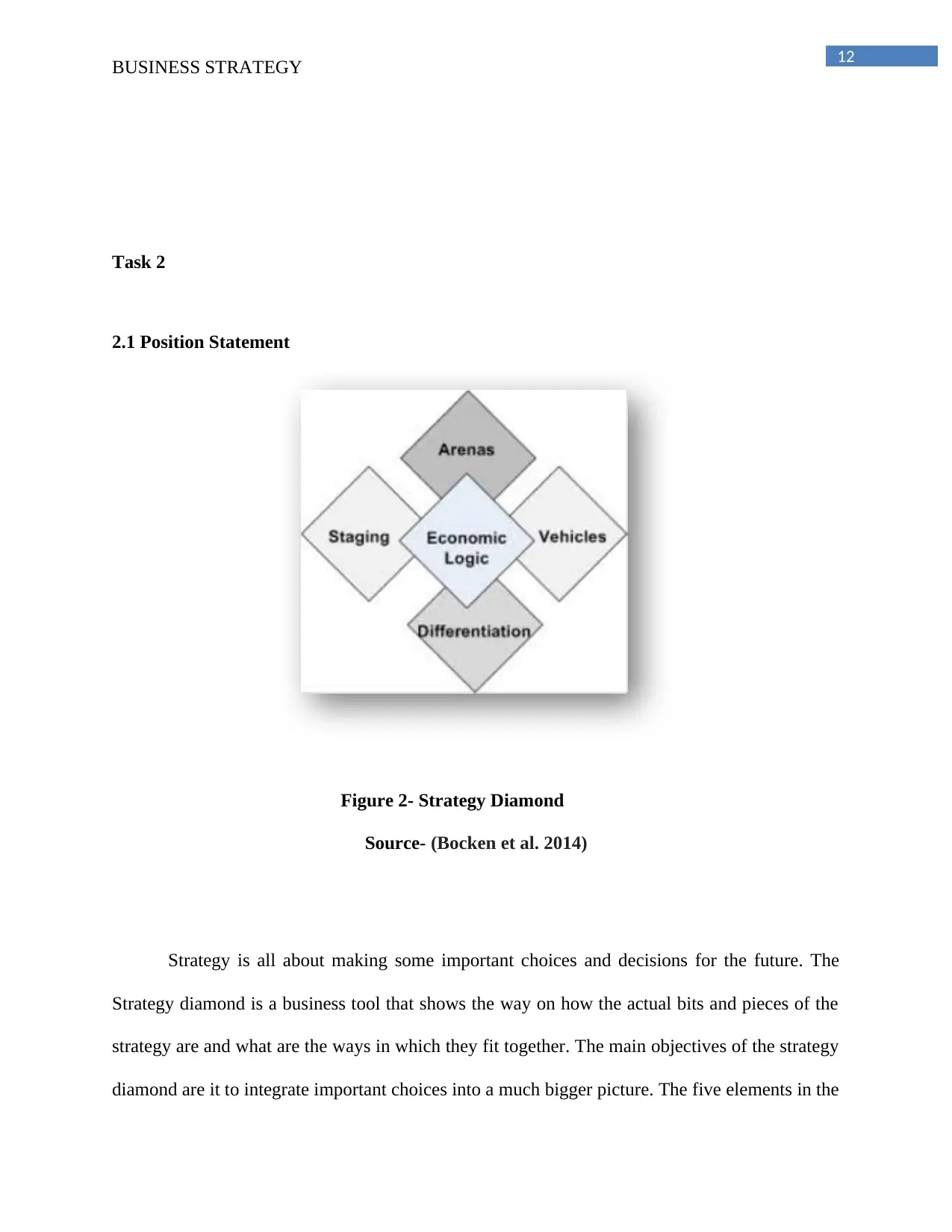
12
BUSINESS STRATEGY
Task 2
2.1 Position Statement
Figure 2- Strategy Diamond
Source- (Bocken et al. 2014)
Strategy is all about making some important choices and decisions for the future. The
Strategy diamond is a business tool that shows the way on how the actual bits and pieces of the
strategy are and what are the ways in which they fit together. The main objectives of the strategy
diamond are it to integrate important choices into a much bigger picture. The five elements in the
BUSINESS STRATEGY
Task 2
2.1 Position Statement
Figure 2- Strategy Diamond
Source- (Bocken et al. 2014)
Strategy is all about making some important choices and decisions for the future. The
Strategy diamond is a business tool that shows the way on how the actual bits and pieces of the
strategy are and what are the ways in which they fit together. The main objectives of the strategy
diamond are it to integrate important choices into a much bigger picture. The five elements in the
⊘ This is a preview!⊘
Do you want full access?
Subscribe today to unlock all pages.

Trusted by 1+ million students worldwide
1 out of 21
Related Documents
Your All-in-One AI-Powered Toolkit for Academic Success.
+13062052269
info@desklib.com
Available 24*7 on WhatsApp / Email
![[object Object]](/_next/static/media/star-bottom.7253800d.svg)
Unlock your academic potential
Copyright © 2020–2025 A2Z Services. All Rights Reserved. Developed and managed by ZUCOL.





